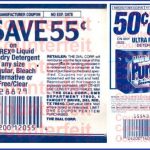
The Coupon Information Corporation keeps an eye out for counterfeit coupons, and alerts retailers and consumers whenever a new one is found. So if a coupon says the Coupon Information Corporation has verified it as authentic, it must be legit, right?
Actually, quite the opposite.
The CIC has issued a public notice, warning retailers that counterfeiters are using the CIC’s name to do exactly what the CIC is trying to avoid – getting cashiers to fall for fraudulent coupons. The counterfeits at issue feature a QR code which, when scanned, reads “***VERIFIED AUTHENTIC*** by Coupon Information Corporation’s coupon verification system.”
Trouble is, there is no such coupon verification system. “The Coupon Information Corporation does not provide QR code verification,” the CIC notice reads, “and has not authorized the use of the CIC name in ANY QR code. Retailers are urged to contact local law enforcement when individuals attempt to use counterfeit coupons bearing the above QR code.”
The counterfeits are meant to mimic the look of printable coupons from the coupon site Hopster, which feature QR codes containing the coupons’ unique IDs. But the fraudulent versions replace the unique QR codes with one that references the CIC’s “coupon verification system.”
The counterfeiters’ use of the CIC name in this way is particularly brazen, since it’s the CIC that’s been working to shut down – not endorse – the continued creation of these counterfeit coupons.
A rash of printable counterfeits, like the ones bearing the fake QR codes, trace their origin to a shady internet tutorial called “The Art and Science of Coupon Creation”. Similar to the earlier guide “How to Make Coupons,” but much more advanced, the tutorial contains everything one might need to create and print their very own fake coupons.
There are authentic-looking templates to assist in creating coupons that look like they came from Coupons.com, SmartSource, RedPlum, Hopster and others, plus software that creates customized bar codes that will scan at the checkout, product image files, and tips on how to write believable fine print. The kit also comes complete with watermarks, unique IDs and other security features – such as QR codes suggesting CIC approval – to make even the most audacious, high-value, hard-to-believe coupons look completely legit.
“Don’t be discouraged if at first it takes you a long time to make your first coupon,” the tutorial reassures users. “The more you make, the faster you get… If you follow these lessons closely, you will have great success making all kinds of coupons.”
If you’re curious – or perhaps a budding counterfeiter – don’t go Googling “The Art and Science of Coupon Creation” in the hopes of trying it out for yourself. You’ll only find the tutorial on the shadowy underground website Silk Road, and you can’t get to the “deep web” site just by typing “Silk Road” into your web browser. The online marketplace, hidden behind layers of encryption and anonymity, is like eBay gone wild, where illegality runs rampant. Drugs are a particularly popular item for sale, which prompted the FBI to shut down the site and arrest its founder late last year. But a group of users later relaunched the site, restoring anonymous online shoppers’ access to their illegal drugs and counterfeit coupons.
It’s worth noting that the creator of the original “How to Make Coupons” guide was ultimately tracked down, tried and convicted of wire fraud and trafficking in counterfeit goods. The CIC and others are hoping the same will occur with the brains behind “The Art and Science of Coupon Creation”.
And now that the CIC has warned retailers that every coupon bearing its stamp of approval is counterfeit, and has urged retailers to call the police on anyone who attempts to use one, perhaps the tables have been turned once again – this time, on the counterfeiters themselves.










